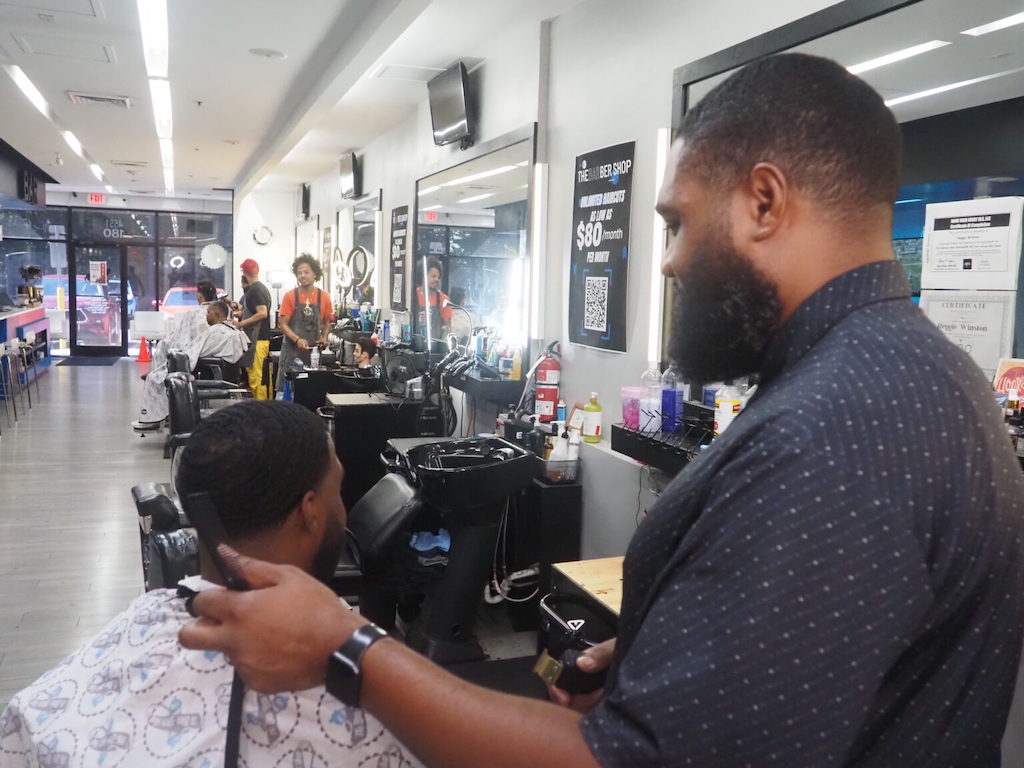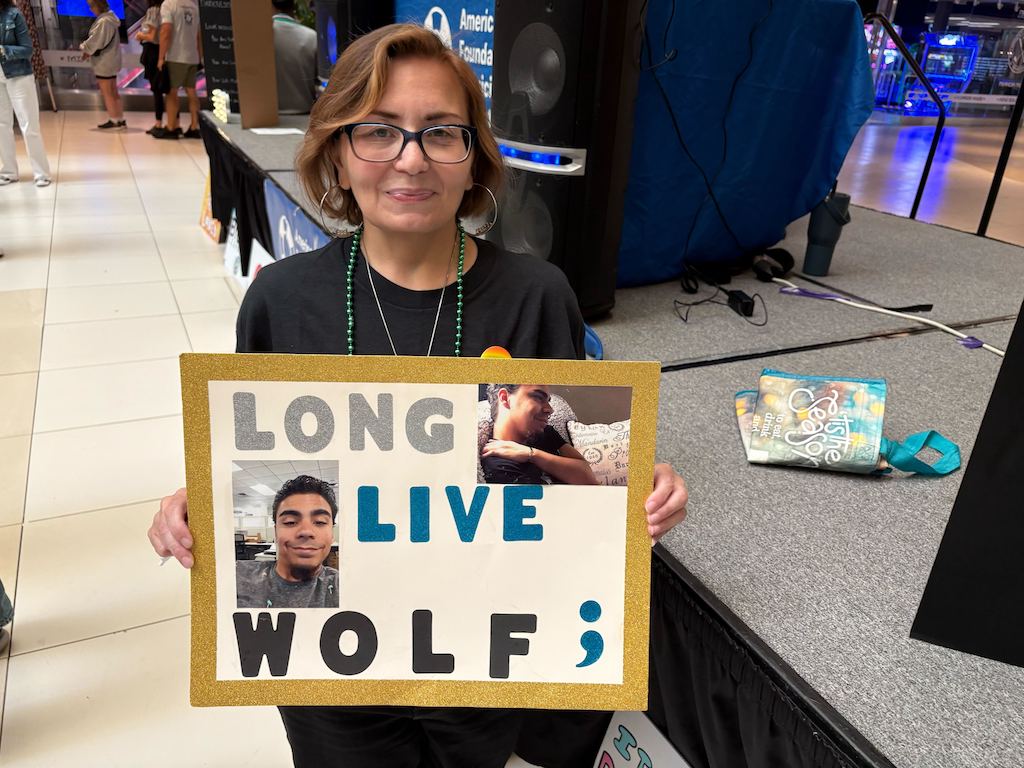Jessie Edmond holds a photo of her son, Julian “Wolf” Rivera, who died at 27 in 2019 in Middletown, N.Y. Suicide has increased for Gen Z adults ages18-27 since 2014, when the millennials were in early adulthood, with most of the increase among Black and Hispanic men. (Photo by Tim Henderson/Stateline)
Editor’s note: If you or someone you know needs help, the national suicide and crisis lifeline in the U.S. is available by calling or texting 988. There is also an online chat at 988lifeline.org.
For Gen Z adults, the oldest of whom are now reaching their late 20s, suicide is taking more lives than 10 years ago when millennials were the same age, according to a Stateline analysis of federal death statistics.
The bulk of the increase, 85%, is among Black and Hispanic men, many in Southern and Midwestern states.
Experts disagree on the root causes of the growth in suicides, but they see a wave of untreated depression that can lead to suicidal thoughts, one that affected all age groups after the Great Recession but lingers on among young adults, especially non-white men.
Theories behind the increase range from bullying on social media, since Gen Z was the first generation to grow up with the internet, to economic despair, to cultural resistance to seeking help for depression.
!function(){“use strict”;window.addEventListener(“message”,function(a){if(void 0!==a.data[“datawrapper-height”]){var e=document.querySelectorAll(“iframe”);for(var t in a.data[“datawrapper-height”])for(var r,i=0;r=e[i];i++)if(r.contentWindow===a.source){var d=a.data[“datawrapper-height”][t]+”px”;r.style.height=d}}})}();
Gen Z suicides have continued at a fast pace this year, with 1,148 in January and February, the latest months available from the federal Centers for Disease Control and Prevention, about the same as in 2024. The CDC bases its data on death certificates.
Among those grappling with the crisis is Rodney Harris of the University of North Carolina School of Medicine, who has enlisted barbers and churches in his state to draw out stories of personal pain before they lead to a suicidal crisis. Harris is an associate professor in the school’s Suicide Prevention Institute.
He’s fighting a perception that you can shake off mental health issues on your own.
“The research tells us that we have got to find a live person to go to them, particularly Black and brown kids, because if we don’t, they’ll get lost,” said Harris. “There’s a perception that you’re going to be strong and not complain about things, and that can keep you away from treatment.”

Some visible signs of the crisis have shaken communities in recent weeks.
A bridge in majority-Hispanic Taos County, New Mexico, closed to pedestrians in September after a rash of suicides, including that of a teenager less than two weeks ago.
Also in September: A Black 21-year-old student hanged himself from a tree on a Mississippi university campus, authorities said, in a case that raised fears of lynching before his death was ruled a suicide.
For Julian “Wolf” Rivera, who died at 27 in 2019 in suburban Middletown, New York, there was a combination of issues, his mother said: pressure to support a growing family with a second child on the way, a night job in a warehouse that he found unfulfilling, discrimination he felt because of his Hispanic background despite being born and raised nearby by parents with a Puerto Rican heritage.
Rivera also struggled to accept and then to find help for his mental health issues, said his mother, Jessie Edmond.
“He was diagnosed with depression. He used to get angry. ‘Why? Why do I need medicine to be normal?’” Edmond said. “He would take medicine, go to therapy, feel better and say, ‘I don’t need medicine anymore.’ When he was in crisis he finally reached out, but nobody was taking patients. No one called him back.”
Like many states, New York is facing the unexpected loss of millions of dollars for mental health programs as part of cutbacks by the Trump administration’s Department of Government Efficiency task force. Federal grants for mental health crisis teams and drug treatment were cut by $88 million in April, and more cuts are feared as President Donald Trump’s One Big Beautiful Bill Act takes effect.
Among other things, the federal government in July ended an LGBTQ+-specific suicide helpline for people under 25.
A growing awareness of the suicide problem among young people led to federal responses, including a 2019 Congressional Black Caucus report on suicide among young Black people. But some of those programs are facing setbacks under the new Trump administration, and they could disappear or be forced to rely more on already stressed state funding.
More despair
Suicides increased among Asian, Black, Hispanic and Native young adults, according to the Stateline analysis, with Native people having the highest rate in both 2014 and 2024. The number of suicides dropped slightly for white people, but increased as a rate because population fell as Gen Z took over the age bracket from the more numerous millennial generation.
Suicide became the second-highest cause of death for young Hispanics, surpassing homicide, and became the No. 1 cause of death for young Asians, surpassing accidents. Men have the highest rates, especially Black and Hispanic men, who together account for 85% of the total increase in suicide, 822 of 965.
Young white adults had a higher suicide rate in 2014 than Black or African American people, but by 2024 the rate for young Black adults was higher. Men have the highest suicide rates but the rate for women is growing faster, from about one-fifth of the rate for men to one-fourth in 2024.
The largest increases in suicide rates for the age group were in Georgia (up 65%), North Carolina and Texas (up 41%), Alabama (up 39%) and Ohio (up 37%).
The highest rate is in Alaska, which was also highest in 2014, up 34% to a rate of 49 suicides per 100,000 population, followed by New Mexico and Montana. The lowest rate was in New Jersey, with a rate of 6.9, a decrease of 31% since 2014, when it was ranked No. 47 behind California, New York and Massachusetts.
!function(){“use strict”;window.addEventListener(“message”,function(a){if(void 0!==a.data[“datawrapper-height”]){var e=document.querySelectorAll(“iframe”);for(var t in a.data[“datawrapper-height”])for(var r,i=0;r=e[i];i++)if(r.contentWindow===a.source){var d=a.data[“datawrapper-height”][t]+”px”;r.style.height=d}}})}();
Harris’ work in North Carolina was part of the federal Black Youth Suicide Prevention Initiative, under the Substance Abuse and Mental Health Services Administration. The state, along with others, also used a one-year federal grant to enhance access to mental health services for young people.
North Carolina’s health department has pledged to continue the work, Harris said. The state “remains committed to providing resources to communities which have been marginalized and where mental health challenges persist,” a state health department spokesperson, James Werner, told Stateline in a statement.
The federal initiative was formed to reduce suicides among Black young people and children, with 15 states and the District of Columbia chosen to make state-specific policy plans: Georgia, Illinois, Indiana, Kentucky, Louisiana, Maryland, Michigan, Minnesota, Mississippi, North Carolina, Ohio, Oklahoma, Oregon, Pennsylvania and Tennessee.
North Carolina and Minnesota have released action plans based on the program. And other states have also taken action: Louisiana created promotional campaigns to reach young people at a rivalry college football game, and Oregon developed a youth-led suicide prevention coalition with matching funds from the state health department.
Georgia stands out for the biggest change in youth suicides; they rose 70% to 311 deaths in 2024. The state used two federal programs, the youth suicide prevention initiative and one from the U.S. Office of Minority Health to the medical school at Morehouse School of Medicine, to look for policy solutions to high suicide rates.
A report from the medical school outlining policy recommendations is nearing completion, said Susan McLaren, an assistant project director with the Georgia Health Policy Center at Georgia State University, which is evaluating the ideas.
The medical school is embracing the concept of “nothing about us without us” that brings in young people to lead decision-making about suicide prevention policies, McLaren said.
“The current crisis among our Black youth is a result of many things: stigma, lack of resources and treatment, and insufficient focus on creating safe spaces and dialogue to prevent and intervene in mental health challenges,” McLaren said.
McLaren declined comment on funding issues, but the staff at the Office of Minority Health, which provided the Morehouse grant, has reportedly been slashed in a Trump administration reorganization.
Another federal program at SAMHSA, the Garrett Lee Smith State/Tribal Youth Suicide Prevention and Early Intervention Program, gives grants of up to $735,000 to states and tribes to fight youth suicide. The program is named for the son of Republican U.S. Sen. Gordon Smith of Oregon. The younger Smith died the day before his 22nd birthday in 2004.
‘No one magic answer’
The overall crisis in suicide among youth has long puzzled researchers, but it’s associated with an increase in untreated depression, said Dave Marcotte, a professor at American University in Washington, D.C., who wrote about the crisis in 2023 for the National Bureau of Economic Research.
Suicide rates for all age groups fell for decades before rising again starting in 2000, Marcotte said, and getting worse in the Great Recession. Rates for middle-aged people fell back again, but for young people the crisis never abated, he said.
“There’s likely no one magic answer to this,” Marcotte said. “Future job prospects for this generation are not what they were for older generations. Today’s generation is not guaranteed a position in society that’s better than their parents. That’s one hypothesis.”
Today’s generation is not guaranteed a position in society that’s better than their parents.
– Dave Marcotte, American University professor
Another theory: Those born after 1995, including Gen Z adults, are the first to spend their entire adolescence with smartphones and social media. Substituting in-person socializing with bullying-prone online chatting is a prime cause of young depression, said Jean Twenge, a psychology professor at San Diego State University, who wrote an influential 2017 article in The Atlantic with the headline “Have Smartphones Destroyed a Generation?”
Heavy users of social media are more likely to be depressed, Twenge told Stateline, even among marginalized groups. And politics seems to play little part, she argues. In a post this May, Twenge noted that increases in Black and Hispanic depression began in 2012, as President Barack Obama was about to be elected to a second term, and well before Donald Trump was elected for the first time.
That same year, though, saw virulently racist memes and hate speech become increasingly widespread on Facebook and Twitter as Obama ran for reelection.
Researcher Jonathan Haidt added another reason why today’s youth might face more mental health challenges: When they were children, parents became more leery of letting them play unsupervised as fears of kidnapping and abuse increased. So they spent less time learning to interact face-to-face and more time in an adult online world they weren’t prepared to handle.
“These two trends — overprotection in the real world and underprotection in the virtual world — are the major reasons why children born after 1995 became the anxious generation,” wrote Haidt, a professor at New York University, in his 2024 book “The Anxious Generation.”
Stateline reporter Tim Henderson can be reached at thenderson@stateline.org.
This story was originally produced by Stateline, which is part of States Newsroom, a nonprofit news network which includes Georgia Recorder, and is supported by grants and a coalition of donors as a 501c(3) public charity.




